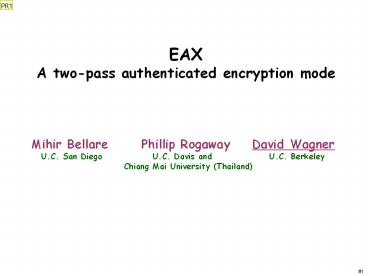EAX - PowerPoint PPT Presentation
Title:
EAX
Description:
A two-pass authenticated encryption mode. Mihir Bellare Phillip Rogaway David Wagner ... One-pass provably secure ... Encrypt and authenticate in one pass ... – PowerPoint PPT presentation
Number of Views:63
Avg rating:3.0/5.0
Title: EAX
1
EAX A two-pass authenticated encryption mode
Mihir Bellare Phillip Rogaway David Wagner U.C.
San Diego U.C. Davis and
U.C. Berkeley Chiang Mai University
(Thailand)
2
Summary of our work
- Authenticated encryption (AE) modes of
operation - Encrypt for confidentiality
- Authenticate for integrity
- Goal Auth. encryption with associated data
(AEAD) - Support associated data (AD) - e.g., packet
headers - that should be authenticated but not
encrypted - Additional goals
- Flexible, general-purpose, suitable for
standardization - Patent-unencumbered
- Provably secure
- Our solution EAX
3
1st generation ad-hoc schemes
- Many schemes proposed and used in practice
- CBC with xor checksum
- PCBC
- Kerberos CBC with CRC checksum
- IPSecs old ESP o AH
- IPSecs new ESP
- SSL/TLS
- SSH
- IEEE 802.11 WEP
- IAPCBC
- None of these were proven secure
4
2nd generation provable security
- Generic-composition encrypt-then-authenticate
- Advantages
- Provably secure Bellare,Namprempre Krawczyk
- Supports associated data a AEAD scheme
- Unpatented
- Disadvantages
- - Strict IV requirements if one uses standard enc
schemes - - More key material, longer key-setup time
- - No standard, no specs
5
3rd generation One-pass provably secure AE(AD)
- IAPM Jutla, OCB Rogaway, XCBC Gligor,
Donescu - Advantages
- Encrypt and authenticate in one pass
- Fast takes about n block-cipher calls to
process n blocks of data - Disadvantages
- - Some modes cant handle associated data
- - Some modes are not fully specified
- - All are patent-encumbered
- Due to patent concerns, adoption of these modes
has been limited
6
4th generation Unpatented two-pass AEAD
- CCM CTR CBC-MAC Whiting, Housley, Ferguson
- EAX builds on CTR and OMAC
- CWC builds on CTR and hash127 Kohno, Viega,
Whiting - GCM builds on CTR and GF(2128) univ hash
Viega, Whiting - Caveat Two-pass modes are typically 2x slower
than one-pass modes, in software
7
Comparison of 4th generation schemes
CCM EAX CWC GCM
Provably secure? ? ? ? ?
Unpatented? ? ? ? ?
Any length nonce? ? ? ? ?
One key? ? ? ? ?
On-line? ? ? ? ?
Can preprocess static headers/AD? ? ? ? ?
Fully parallelizable? ? ? ? ?
Preserves alignment? ? ? ? ?
Fully specified? ? ? ? ?
8
Iwata, Kurosawa
OMAC
L p (0n) 2L msb(L)? Lltlt1
Lltlt1 Å 0x87 4L 2(2L)
Tweaked OMAC OMACkT(x) OMACk(T x)
9
Security of OMAC?
Theorem slight improvement of IK Suppose
there is an adversary A that attacks
OMAC?E using time t and s blocks worth of
queries getting PRF-advantage Advprf
d Then there is an adversary B that attacks
E using time t tiny and s 1 blocks of text
and getting PRP-advantage Advprp d (s3)2/2n
OMAC?E
E
10
input
output
EAX
11
input
output
EAX2
12
Auth Encryption with Associated Data (AEAD)
Syntax of an AEAD scheme E Key
Nonce Header Plaintext Ciphertext
D Key Nonce Header Ciphertext
Plaintext È invalid
- Security of an AEAD scheme
- Privacy ( IND-CPA) next slide
- Integrity ( INT-CTXT) following slide
13
RBB,BDJR,GM,R
Privacy of an AEAD Scheme
Real world
A is not allowed to repeat an N-value(nonces
should be unique)
14
RBB,BR,KY,GMR,R
Integrity of an AEAD Scheme
- Adversary A forges if it
- outputs N H C s.t.
- C is valid (it decrypts to a
- message, not to invalid)
- There was no earlier query
- N H M that returned C
N H M
Real
A
N H C
AdvAUTH (A) PrAReal forges
P
A is not allowed to repeat an N-value
15
Security of EAX
Theorem Suppose there is an adversary A that
attacks EAXE using time t and s blocks of
chosen text getting privacy or authenticity Adv
d . Then there is an adversary B that
attacks E using time t tiny and s tiny blocks
of text and getting PRP-advantage Advprp d
11s2/2n .
EAXE
E
If you believe that E is a good block cipher,
you are forced to believe that EAXE is a
good AEAD scheme.
16
Why use EAX?
- EAX is secure
- Provably secure, if underlying block cipher is
secure - Single API for naïve programmers avoids many
pitfalls (e.g., poor IV handling, encrypt
without auth, etc.) - EAX is easy to use
- One mode of operation provides everything you
need - Nonces need only be non-repeating (dont need to
be random) - Nonces, headers, and messages can be of any bit
length - EAX is good for performance
- On-line Can process streaming data on-the-fly
- Can pre-process static headers
- No encodings, no unaligned operations
- Single key minimizes space and key-schedule
operations - Caveat EAX is 2x slower than IAPM/OCB/XCBC
- EAX is unpatented free for all uses (as far as
we know)
17
Questions?































